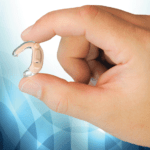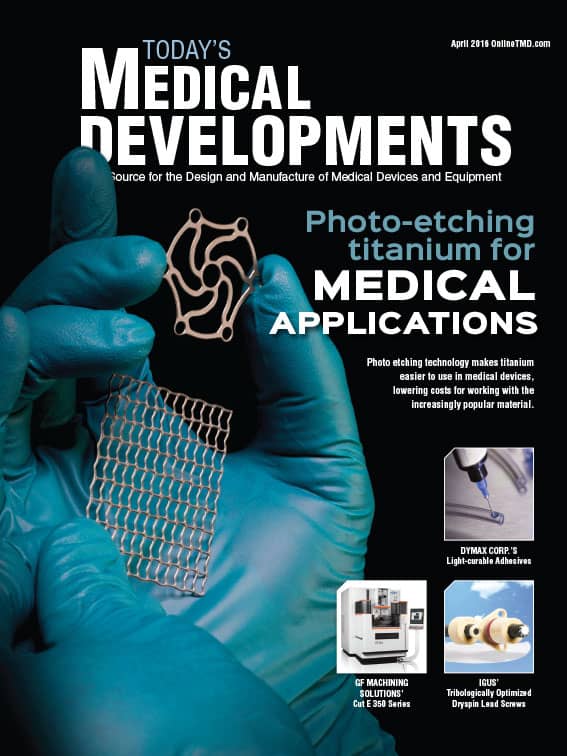Today’s Medical Developments,
May Edition: Design Section.
Published April 22, 2016
by Arielle Campanalie.
Low cost, high-quality hearing aids
Dr. Sreekant Cherukuri, founder of MDHearingAid, designs affordable one-size-fits-most hearing aids for those who cannot afford custom devices.

Among adults 70 and older with hearing loss, fewer than one in three (30%) who could benefit from hearing aids has never used them, according to the National Institute of Deafness and Other Communication Disorders (NIDCD). Even fewer adults 20 to 69 (approximately 16%) who could benefit from wearing hearing aids have never used them. And there’s a large contributor to this – cost.
Dr. Sreekant Cherukuri’s life’s work has been bringing this traditionally expensive necessity to the masses at an affordable price with his company, MDHearingAid, which also caters to younger individuals with hearing problems, providing more aesthetically pleasing product designs. Today’s Medical Developments (TMD) sat down with Cherukuri to talk about his company, founded in 2009, and how he achieves these low-cost hearing solutions through research and development (R&D) and manufacturing.
TMD: What were the goals with these devices?
Sreekant Cherukuri: As a young medical student I wanted to help people. As I became an experienced doctor and surgeon, I grew increasingly frustrated that I couldn’t always help my patients who had hearing loss because hearing aids were priced out of their reach. I resolved to do something about it and founded MDHearingAid. Thirity-five million people in the U.S. have hearing loss but only about 25% use hearing aids. That means that about 28 million Americans are not reaping the benefits of hearing amplification. My personal goal is for our company to help 1 million people hear better affordably by 2020 – and we are already a long way to that target.
TMD: What was the R&D process of the MDHearingAid?
SC: R&D is a constant process for us and I’m not sure we’ll ever be finished. In the beginning, I assembled a team of well-respected peers and audiologists. Together we examined, studied, and manually combed through a great deal of data from both component suppliers and patients. We put that data together with our years of clinical experience and were able to create a hearing aid which helps just about everyone with typical hearing loss (between 80% to 90% of most patients). That aid, the MDHearingAid PRO, is still in production and is delivering quality sound at a price just about everyone can afford.
TMD: What obstacles did you have to overcome in designing affordable hearing aids?
SC: There are only so many designs that will work with the shape and position of the ear itself. The behind-the-ear (BTE) design is tried-and-true and very popular, but primarily, it’s the simplest to wear. In-the-ear (ITE) designs have issues with the occlusion, that plugged up feeling, and with earwax clogging various parts. But our new FIT aid is unique in that it sits in the concha, or outer bowl, of the ear. Its design takes advantage of the ear’s natural design to funnel sound directly to the aid. But the FIT doesn’t block the ear canal or require custom moldings like other ITE aids do.
I think we’ve combined the best hearing aid components with an innovative, patented design and overcome the disadvantages of the prevailing styles all in this one aid. And it costs about one-fourth the cost of the average traditional hearing aid.
TMD: What made you decide on the youth market?
SC: We used to think of hearing loss as being someone’s grandmother’s problem since hearing typically declines with age. That’s no longer the case.
In fact, the majority of people with hearing loss in the U.S. are under the age of 65. We are seeing more and more patients with significant hearing loss as early as the late teenage years. Noise-induced hearing loss is a growing problem in this country. We are connected to phones and music players, often for hours each day. When our ears are exposed to harmful noise, delicate cells in the inner ear become damaged. Unfortunately, the damage is cumulative throughout time and irreversible. So, college students and people just starting their careers, who are far from old, are having trouble understanding others and struggling with hearing-loss-related issues that doctors didn’t normally see until patients were in their 50s. We are simply here to help those young adults who find themselves needing an affordable hearing solution.
TMD: Has that market proved to be strong?
SC: Sadly, since most people didn’t realize that the ringing or buzzing in their ears after concerts or sporting events is a sign that their hearing was being damaged, the market has been stronger than any doctor would like. We advocate strongly for hearing protection, because hearing loss is 100% preventable. Education about preventing hearing loss is vitally important, especially for youth who may feel invincible.
TMD: Please describe hearing aid manufacturing.
SC: All of our aids are manufactured from the best available components from the U.S. and Europe, in our ISO-certified facilities. We proudly assemble our hearing aids in the United States.
TMD: What are the differences between MDHearingAid’s analog and digital models?
SC: They each have their own strengths. Digital hearing aids are wonderful and have a clean, crisp sound quality. They allow sound-signal processing in a variety of environments, such as noisy restaurants or on windy days. Almost all hearing aids on the market today are digital.
Analog technology is tried-and-true and less expensive than digital. We find that a significant number of users like their sound less processed. Musicians tend to fall in this group. They likely damaged their hearing while playing music without proper ear protection, yet they still enjoy the pure, warm organic sound that analog aids give them. We are one of the only remaining manufacturers producing an analog hearing aid.
You should see a physician and get the best hearing aid you can afford. We offer an excellent choice for those who cannot afford a custom hearing aid. – Dr. Sreekant Cherukuri, founder MDHearingAid
TMD: What are the differences in design between the FIT, the AIR, and the PRO hearing aid models?
SC: The PRO is a BTE aid. The AIR is a mini-BTE aid. Both of these styles have been around for a while and users love them. These styles are easy to use, easy to maintain, and easy to adjust. The FIT is an in-the-ear (ITE) aid that is truly one-of-a-kind. Its design is patented and fits snuggly and completely within the bowl of the outer ear without blocking the entrance to the ear canal.
TMD: What’s in stock for MDHearingAid’s future?
SC: We are continually developing new additions to our product line based upon the feedback we receive from users. However, our primary objective remains in the forefront of our R&D process – we want to put the best technology in a high-quality device and keep the end cost well within reach of those who need our hearing aids the most. As long as there are people who can’t afford to spend thousands of dollars per ear for hearing aids, we’ll be doing our best to give them the help they need at a fair price that’s within reach of most budgets.
MDHearingAid
www.mdhearingaid.com
About the author: Arielle Campanalie is an associate editor for TMD. Campanalie can be reached at 216.393.0240 or acampanalie@gie.net.
